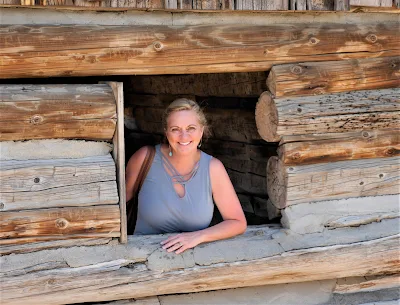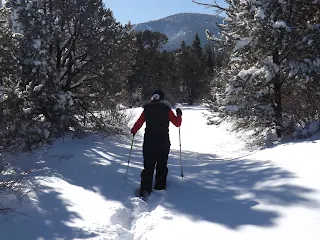On a recent Saturday, I asked Laureen is she had any specific plans for the day.
She knew what that meant.
“A road trip?” she responded.
And, within forty minutes we were on our way to Big Bear, in the San Bernardino Mountains. It is one of our favorite haunts.
Haunts – I like that, since it is October. That spooky time of year.
Big Bear – there is Big Bear City and Big Bear Lake, for those who haven’t travelled Highway 18 to either of those locales. Traveling this road is to witness tall glorious pine trees, a blue lake, hiking trails, off-road trails, eating and shopping in the Village, and so much more.
We love the Big Bear area.
“I love the Big Bear area,” I stated.
“I know,” Laureen responded. “Where are we going to lunch?”
I knew the right spot. A place that is internationally known as a very haunted and goose bumpily place. The Captains Anchorage.
“We haven’t been there in a dozen years,” Laureen stated.
“And the spirits are angry about that,” I said. “The tip you left last time was rather vacuous.”
Laureen ignored that.
Driving by the Mitsubishi cement plant, south of the town of Lucerne Valley on Highway 18, always reminds me of a space colony. Huge round storage buildings with conveyer belts going this way and that way has an out of this world appearance.
“Doesn’t it look like space aliens have captured humans and sent them to work in their factory?” I asked Laureen as we drove by the place.
She shook her head. “Looks like a cement factory.”
“Human, we do not enjoy your remarks – to the mines with you.” I stated.
Laureen ignored me again.
As we swung around Baldwin Lake, we had some time to kill before the restaurant would be open, and decided to take the scenic route through Holcomb Valley. Actually, I had intended on the drive to snap a photograph of the ‘hanging tree’ in the area where the old mining town of Belleville once stood.
I wrote a column on Holcomb Valley for the Daily Press Newspaper, back in June of 2020, but I won’t go into any detail about that trip now. I don’t like repeating myself – unless it is to our children, and I can go on and on and on about the same subject for weeks.
Since Belleville, like many mining camps, could be a violent place – there had to be some place to punish those who thought killing one another was a perfectly fine way in dealing with personal disputes.
It was the Wild West, after-all.
So, the townsfolk found a nice big and tall Juniper tree to string up the really bad hombres. Is the tree haunted? Don’t know and never asked – but with its outstretched tree limbs and prominent location in the valley, it could be.
“Almost lunch time,” I said to Laureen.
As we headed out of the valley, we came across a tree that made the hanging tree look downright tame.
There in the middle of a clearing, we were staring at an apparition that film director, Tim Burton would find alluring.
Gnarled leafless branches tweaked in such a way, it appeared as if it was alive and trying to reach and grab any unsuspecting person sauntering by. Not a stich of green on it – only the tall barren trunk hunkered down in the soil.
.JPG) |
| The Hanging tree in Holcomb Valley |
“That looks as if it’s haunted?” Laureen asked.
“I’ll come back, and pick you up in the morning – let me know about your research.”
We headed out for lunch at that time.
The Captain’s Anchorage, is located in Big Bear Lake, and has been a landmark for the city since 1947, when the owner, Andy Devine opened it. The famous actor turned restaurateur, wanted something special to entertain his Hollywood friends, and thus the restaurant and bar became the center point not only for the locals, but many other famous actors. Roy Rogers, John Wayne, Lee Marvin, Jimmy Stewart, and many more made the long drive from Los Angeles to the mountain community of Big Bear Lake to partake in the extensive menu offerings.
The original name of the place was the Sportsman’s Tavern, and remained that way until 1972, when it was renamed The Captains Anchorage by Woodrow and Charlotte Meier, who had purchased the restaurant from Devine in 1966.
It is a beautiful building full of character and grace – and it is haunted.
.JPG) |
| Besides being haunted, a great place to eat |
As we entered the business, I walked over to the dark wood bar, located in the Andy Devine Room, and snapped some photographs. That’s what I do – don’t look at the menu first – just snap some shots. Perhaps there will be an orb floating somewhere in the photograph when I download it later.
“Have you come to see George?” Natalie asked from behind the bar. Natalie has worked at the Captains Anchorage a long time, and knows a bit about the history.
“George is our local ghost,” she stated. “He likes to hang around the bar, causing some mischief now and then, but doesn’t hurt anyone.”
“You’re a believer then?” I asked.
“I don’t belong to a cult, if that’s what you are asking?”
“No, not that kind of a believer,” I replied. “Have you had any interaction with George?”
Natalie nodded. “Once in a while a light will turn on when no one is here but me, or the glass washer will suddenly light up. Those kinds of things.”
Laureen was standing to the right of the bar, near the kitchen entrance, and I saw a peculiar look on her face.
.JPG) |
| The main bar at the Captains Anchorage |
“You feeling something?”
“Yes, there’s something here between the bar and the fireplace,” she responded. “It’s like someone being anxious. As they are troubled by something – I really can feel the emotions.”
Laureen is so much more sensitive than me, when it comes to practically anything – except those sad mistreated dog commercials – they tear me up. A box of tissues, please.
“Did you feel anything?” she asked me.
I nodded. “Yes, I feel the bar is calling me over for a cold one.”
According to Patti Scriven, the current owner and daughter of the Meier’s, George was Andy Devine’s ‘bookkeeper’. During the time period that Devine was the owner, there was lots and lots of rumors of illegal gambling going on at the Sportsman’s Tavern. In fact, upstairs are small booths which are original to the design of the restaurant, that look like the perfect size for a slot machine placement. Poker games, roulette, and possibly betting on horse races, may have taken place in the establishment.
 |
| John R Beyer and Patti Scriven in the Captains Anchorage |
Was George just a bookkeeper or perhaps a bookie also?
“Rumor has it that George may have been embezzling profits from the illegal gambling,” stated Patti. “He may had been afraid of getting caught and committed suicide at his house, not far from here."
“Then why would he haunt this place?” Laureen asked.
“We have had numerous of those paranormal investigators out here, and they all say the same thing, he was the most happy here at the restaurant,” Patti replied.
“It is a very nice place to haunt,” I stated.
Some research I conducted, showed George may have also been killed by some angry gamblers or those who caught him skimming money off the top of the receipts.
Either suicide or murder makes for a possible haunting.
.JPG) |
| Once an illegal gambling booth now a nice place to sit and eat |
It seems as though George does truly like haunting the restaurant, its patrons and staff. He, according to Patti, has never caused any harm to anyone personally.
“There’s been some liquor bottles shattering behind the bar when no one was present, some tromping of heavy footsteps up and down the stairs, blowing out some candles, and the like. Pretty harmless – more like pranks.”
Shattering an expensive bottle of spirits is not a prank. That would be a felony in any ghostly realm.
“Listen, Mr. Ghost man – I don’t care if it was a prank – that was an expensive bottle of Dalmore sixty-two, there you decided to shatter. Who is going to pay for it?”
Patti entertained us with more tales of the mischievous George, but stated she had never had a true other-worldly experience with the ghost from the Captains Anchorage.
“I wish Rita were here,” Patti stated. “She really has had some recent experiences with George.”
“Please, go on,” I asked.
“Well, recently Rita was near the kitchen when she suddenly saw a dark shadow sweep right beside Hugo, our chef, who was busy cooking. She was scared to death and screamed. When I asked Hugo if he saw or felt anything, he replied just before Rita screamed, he had felt a presence swoosh by him, almost touching him. But, there was nothing there when he glanced around.”
 |
| One of the kitchens at the Captains Anchorage |
“Yes, Rita won’t even go upstairs to get a bottle of wine,” Patti said. “I tease her that a customer wants a certain vintage and will she go up and get it, she just tells me no.”
“I don’t blame her,” Laureen stated.
“Neither do I,” Pattie stated. “I just like to tease her that way.”
Is the Captains Anchorage haunted? I don’t know, but I do know they have great food and a greater tale for their customers.
For further information: https://captainsanchorage.com/
.JPG)
.JPG)








































